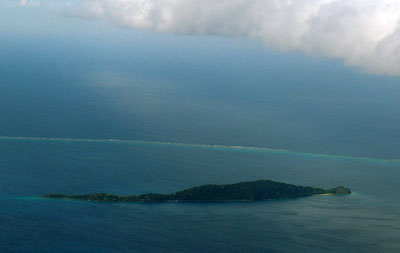
Namena from the air
The island is shaped like a mile-long dragon—a triangular head towards the west, a lumpish body in the center and a long sloping tail pointing east. There are three main beaches with smaller beaches and rocky coastline accessible at low tide. The north is the leeward side, facing the distant island of Vanua Levu, where we started our sea journey. To the south, you can see the even more distant islands of Koro and the former leper colony of Makogai.
Namena wasn’t always uninhabited. There was once a small tribe living there. Tom estimates the island would have supported about 18 people. There is rocky fortification built on the highest point of the island. It affords good views to the sea towards the only opening in the reef. There are several round wells or fire pits built along the hill. Where the volleyball court is not, was once a village. Tom and the men have found scores of pottery shards and other artifacts there and had them dated to 2000+ years old.
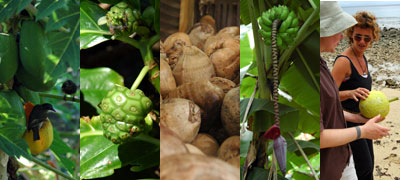
Birds enjoy a ripe papaya; the mysterious medicinal noni; coconuts in storage; bananas; Sara and I examine a fresh breadfruit.
Namena has numerous native food plants. We enjoyed the island’s produce of papaya, coconut, breadfruit, and bull’s heart along with some delicacies Tom imported—bananas, pineapple and Joan’s delicious tomatoes. There’s a vine-y pepper that grows like a weed, pandan (which Fijians don’t eat, though other islanders do), and noni, a medicinal fruit that smells like stinky French cheese when it’s ripe.
I was surprised at how familiar the island’s jungle looked. Aside from the vines, it could have been Mt Takao or the hills of Pennsylvania. There were deciduous trees, jutting rocks, and shrubby undergrowth. My idea of jungle was shattered.
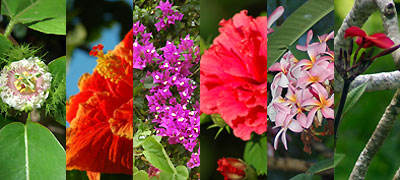
A jungle vine; hibiscus; borganvillea; a viciously red flower; frangipani; tiara
Flowers are Fijians favorite decoration and for good reason. Bougainvillea, frangipani, hibiscus, and tiara grow in abundance. Outside our bure was a stalky varigated plant with red flowers that the honey catchers liked to visit.
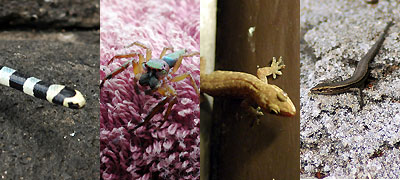
A poisonous seasnake; the spider that jumped on Tod’s nose; a gecko; a blue-tailed skink.
There’s not a lot of fauna on the island, aside from birds (see tomorrow’s entry). We encountered a venomous sea snake, lots of geckoes and blue-tailed lizards, and a rat.
There are plenty of hungry mosquitoes, which contrary to our expectations, are active during the day. Moths and butterflies flutter around. Spiders, pale brown crickets, beetles large and small, and jillions of ants make up the remainder of the island insects.
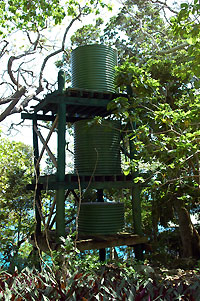 One thing that Namena lacks is fresh water. All the water we drank on the island was rainwater. And Namena doesn’t get a lot of rain, so you want to be conservative in your use.
One thing that Namena lacks is fresh water. All the water we drank on the island was rainwater. And Namena doesn’t get a lot of rain, so you want to be conservative in your use.
An Australian man who came to Namena after WWII to try to recover from his shattering war experience lived on the island for a few months and dug a clever system of channels in the rock cliffs to route rainwater into a holding basin. Tom says that when he first arrived on Namena and camped out to explore the land, he discovered the excavations, cleaned them out and found them quite effective for collecting water. But these days he uses metal and plastic tanks for his water system.
Posted by kuri at October 10, 2004 10:47 AM